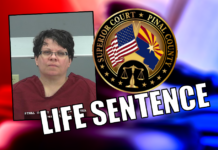Monsoon season can be quite a spectacle. It usually includes heavy rain with flashfloods, spectacular lightning strikes, damaging winds and dust storms accompanying extreme heat.

What is a monsoon? It is the seasonal change in the prevailing winds that brings increased moisture and rainfall to what’s normally a dry region. June 15-Sept. 30 is normally considered to be the monsoon period across the Southwest region of the United States.
Did you know that Arizona averages more than 500,000 lightning strikes in a typical monsoon season? I’m sure everyone has seen the classic pictures of summer lightning strikes in Arizona. They are beautiful; that’s why we often find ourselves going outside to gaze at them when a storm is approaching. Not a good idea! Lightning can strike as much as 10 miles from any rainfall. If you can hear thunder, you are in potential danger. That’s even if the sky is blue.
You can calculate how far away a lightning storm is by counting the number of seconds between witnessing the flash of lightning and the actual sound of thunder reaching your ear. The difference between the speed of light and the sound of thunder is 5 seconds per mile. If takes 30 seconds to hear the thunder crash, the storm is six miles away. This technique is known as the “flash to bang” method.
If the calculated time is less than 30 seconds, the National Weather Service recommends taking cover for at least 30 minutes. All Arizona coaches of outdoor sports are required to abide by this rule. Many have apps on their phones capable of calculating this information.
The standard mantra is, “when thunder roars, go indoors.” Even then, avoid contact with electrical equipment, metal structures and plumbing. Don’t take a shower or wash dishes by hand during an electrical storm. If you own a home, you should install whole house ground fault protection for your entire house at the breaker box.
Other monsoon safety recommendations include:
- Do not crossing flooded roads. Follow the “Stupid Motorist Law” by not driving around barricaded streets. As they say, “turn around, don’t drown.”
- Expect the unexpected. Have a fully charged cell phone, adequate gas, drinking water and an emergency kit.
- If traffic lights are out, treat the intersection like a four-way stop.
- Stay alert in areas of potential falling rocks.
- Replace your windshield wipers in advance, if necessary.
- Reduce your speed.
- Avoid sudden braking.
- Watch for pools of standing water, like along the curbs, to avoid losing control.
- Always be cautious of hydroplaning.
Enjoy the spectacle of Arizona’s monsoons, but be safe while doing it.
See more about safety in hazardous weather here.
Ron Smith is a senior advocate, a member of the Age-Friendly Maricopa Advisory Committee and a member of the Maricopa Community Advocates. He is a CAPS and CLIPP™ certified planner.
This content was first published in the July edition of InMaricopa Magazine.

![Haboob Rolling In 2 [Mason Callejas]](https://www.inmaricopa.com/wp-content/uploads/2021/07/Haboob-Rolling-In-2.jpg)





![Alleged car thief released without charges Phoenix police stop a stolen vehicle on April 20, 2024. [Facebook]](https://www.inmaricopa.com/wp-content/uploads/2024/04/IMG_5040-218x150.jpg)








![City gave new manager big low-interest home loan City Manager Ben Bitter speaks during a Chamber of Commerce event at Global Water Resources on April 11, 2024. Bitter discussed the current state of economic development in Maricopa, as well as hinting at lowering property tax rates again. [Monica D. Spencer]](https://www.inmaricopa.com/wp-content/uploads/2024/04/spencer-041124-ben-bitter-chamber-property-taxes-web-100x70.jpg)